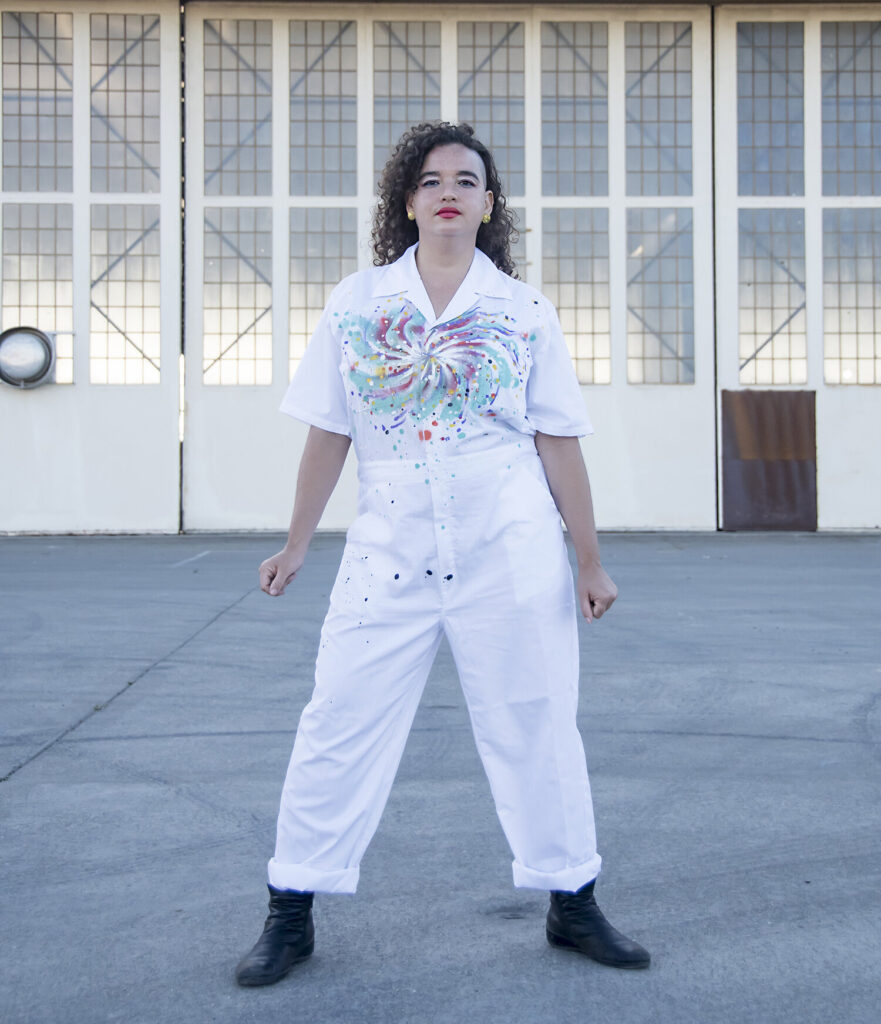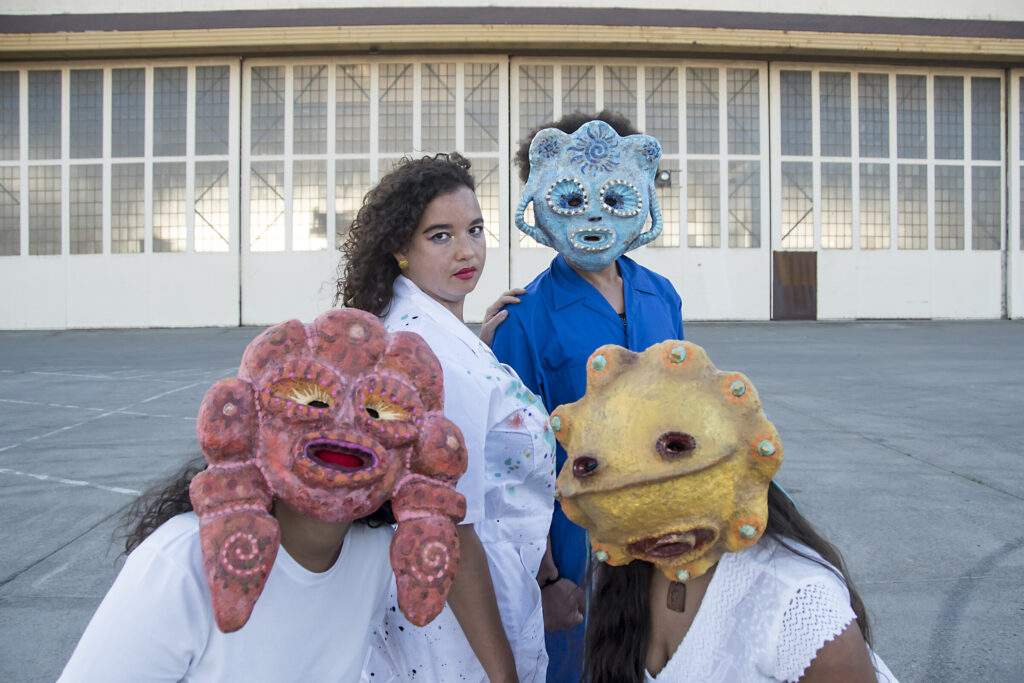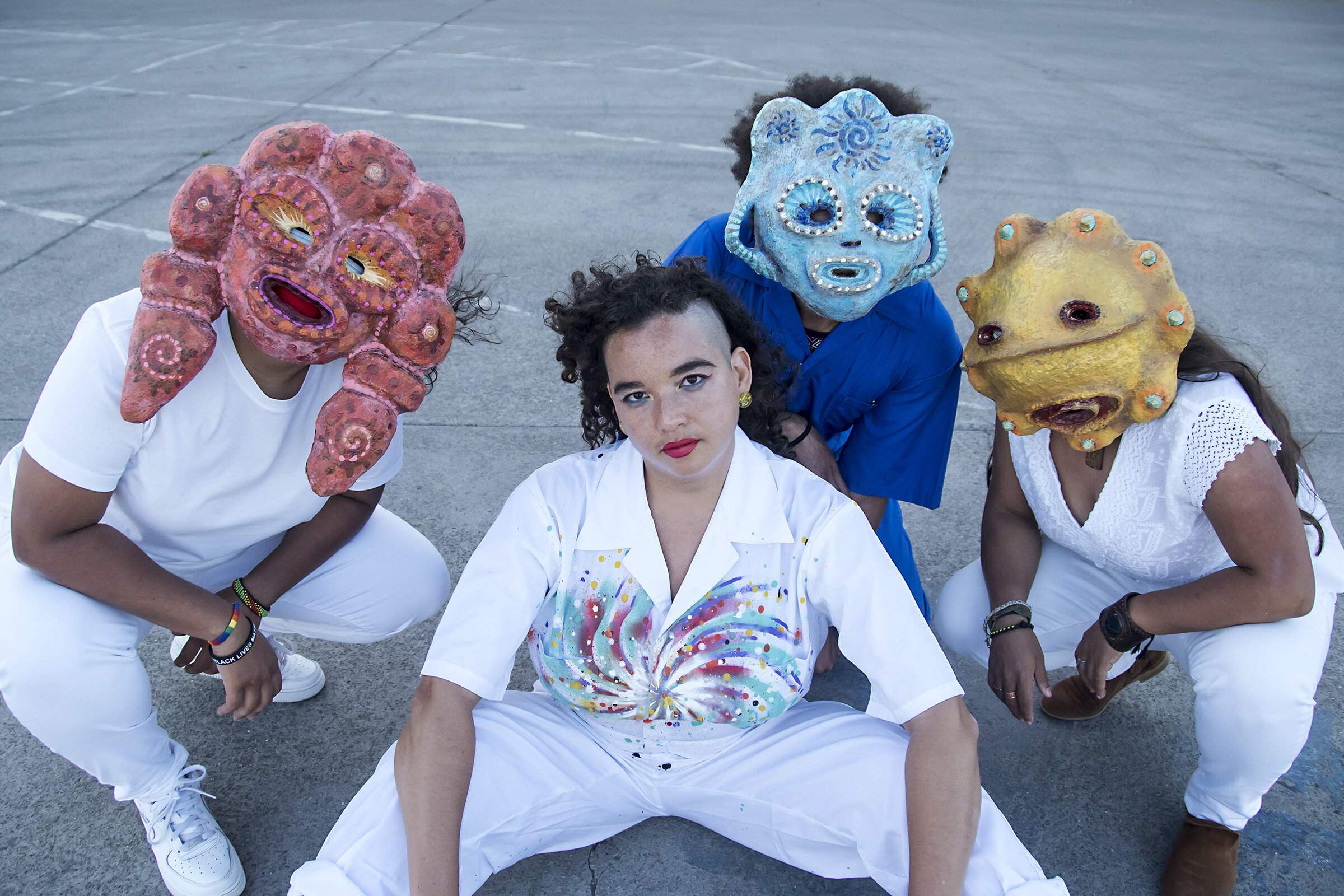Today, Oakland-based musician and acupuncturist MaJo Montijo releases an electrifying bomba dance single called “Huracán.” In it, she ushers in gale-force winds of change on the eve of a historic election—but it might not be the election you’re thinking of. With all due respect to the natural disaster that is US politics, “Huracán” is about freeing MaJo’s homeland of Puerto Rico from US imperialism and economic subjugation, and it comes at a moment when new political movements on the island are talking seriously about decolonization.
“Huracán” is the debut single off MaJo’s forthcoming full-length album, Esotérica Tropical. Directed by Claudia Escobar (Dear Homeland), the music video is a riot of color and emotion that draws from imagery as diverse as Caribbean indigenous petroglyphs and the 2019 twerk protests in San Juan. MaJo has up to this point been known for accompanying herself on the ethereal Celtic harp, so this fully realized bomba hit is a major departure. “Huracán” grew out of years of study with the Oakland bomba culture-keepers Taller Bombaléle and features collaborators from all over the western hemisphere—not least the great bomba percussionists Jesús “El Tambor Mayor” Cepeda and Denise Solis.
It is impossible to understand a rage so great it conjures a hurricane without a bit of Puerto Rican history. MaJo offered a primer on life under colonial rule, before and after Hurricane María, and the resistance movements—from bomba itself to contemporary politics—that are determined to uplift Puerto Ricans. Music this good transcends context and boundaries, so let “Huracán” fill your sails—whatever regimes you seek to overthrow this election.
48 HILLS The title of the song is a reference to Hurricane María, which devastated Puerto Rico in 2017. What was the immediate aftermath of the hurricane like for you, living in the diaspora in Oakland?
MARÍA JOSÉ “MAJO” MONTIJO It was truly heartbreaking and maddening. Every day was full of uncertainty and grief knowing that our people were out there suffering without any government aid—just their own communities coming together to provide mutual aid. The disregard of human life by the federal and local governments became painfully clear. 4,645 people died in the aftermath. We are still grieving them.
Here in the diaspora, we formed networks to facilitate fundraising and other types of support. I would stay up all night, looking at regurgitated news, seeing who and how I could help, sharing information, actively watching the unfolding political disaster. I also produced a fundraising concert with Las Sucias and Taller Bombaléle, and with the money we raised, two volunteer travelers filled 10 suitcases each with water filters, solar powered lights, mosquito repellent, herbal medicine, acupuncture supplies, first aid kits, and even satellite phones to distribute to on-the-ground grassroots organizations.
48H What is life on the island like now, three years later?
MAJO It’s complicated. It’s a continuous colonial disaster. The dictatorial Fiscal Control Board and a very corrupt government pay themselves obscene amounts of money in salaries and contracts while they make Puerto Rico less livable for Puerto Ricans. Tax breaks attract neo-settler colonialists while marginalized communities still struggle to get an actual roof—not a blue tarp—over their heads. Mass migration is emptying the island of Puerto Ricans. Systemic oppression, gendered violence, and PTSD hang thick in the air. The new year started with thousands of earthquakes on the southern side of the island. Five thousand Puerto Ricans became homeless, and then the pandemic happened.
Yet there is hope. There is always hope. The people triumphantly and ingeniously ousted [Puerto Rican Governor] Ricky Rosello in the memorable Verano del 2019. The night Ricky quit, there was a very queer perreo combativo [twerk protest] on the steps of the Cathedral in Old San Juan. It was awesome to watch from afar all the ways people showed up to protest: yoga, fourtracks, horses, kayaks, bomba, scuba diving . . . so much beauty, strength, and resistance. The people are fed up, they are waking up to the fact that not the U.S. or the local government care about their wellbeing.

48 HILLS When did “Huracán” start to take shape for you?
MAJO The song is the result of years of bomba dance and drum study with Taller Bombaléle, an Afro-Puerto Rican educational and performance project based in Oakland. It was founded by Julia Caridad Cepeda, whose family has preserved, lived, and breathed bomba culture for seven generations, and Denise Solis, a Chicana union organizer and founder of one of the first all-female bomba groups, Las Bomberas de la Bahía. Bomba is Puerto Rico’s oldest living resistance roots music, originating as part of the survival and fugitivity strategies of African slaves on the island.
The batey [bomba song, drumming, and dance circle] is a space where we spontaneously gather, creating a ceremony that connects us with our Afro-Indigenous ancestors. In the batey, we process our emotions, find healing, and envision the future we want together. The song evolved naturally in the batey, as I improvised additional lyrics speaking out against femicides: “Ni una mujer más” [not one more woman]. This is a demand that touches me deeply because I know first-hand what it feels like to not feel safe when you walk down the street alone—even as a young girl—growing up in Puerto Rico.
48 HILLS How would you describe the message of this song?
MAJO This song is a battle cry, condemning the harmful impacts of the federally appointed Fiscal Control Board [commonly known as La Junta] and of the colonial government. It expresses a collective rage at the continuous extraction, injustices, and economic slavery the island is subject to by U.S. imperialism.
Borikén, as the Taínos [indigenous people of the Caribbean] named the island, is one of the oldest colonies in the world. Five hundred and twenty-eight years of colonization—yet we, the people of Puerto Rico, are obligated to pay an illegal and unjust debt? Boricuas [Puerto Ricans] suffer through an austerity agenda so that this debt can be “restructured.” The authorities close hundreds of schools, try to sell our most precious natural resources, try to cut people’s pensions, try to dismantle the public universities, sell land for cheap to Monsanto so they can keep experimenting on us, and keep polluting the island. It’s insane.
In my opinion, the empire owes us—we don’t owe it shit. When I sing “y no la vamos a pagar” [we are not going to pay the debt] the coro singers [chorus] wave their fingers in the air signaling “no” as they sing it at the top of their lungs, the drummers speed up, and we feel a spiritual and electric air of joyful and fierce resistance.
This song emerges from a personal exploration of decolonial practices: how is it to act from a place of freedom as a colonized being? How can we act as disruptors of systems of oppression in our daily life? It affirms that, for a colonized person, self-love, cultivating our dreams, envisioning the future that we want, and stewarding the land is political.
48 HILLS The chorus builds and builds to where I could almost feel the winds picking up into a hurricane of rage and righteousness. What did it feel like to draw from that destructive imagery to imagine a different future?
MAJO The energy of the song is inspired by spirits of wind and storms such as the Yoruban orisha Oya and the Taíno deity Guabancex, who both represent the destruction we sometimes need in order to clear out the old and start anew. You can see Guabancex represented in the “Huracán” video, personified by the character in the blue mask. Our ancestors speak to us, have our back, and want us to shake things up so that future generations can be free. Wind is an awe-inspiring, genuinely destructive force, but can also be a life force and an impetus for movement. In the lyrics of the song, I talk about wind blowing away the Fiscal Control Board, freeing us from colonial oversight and oppression.

48 HILLS The imagery of the music video is stunning. What are all the references you are weaving together?
MAJO The bomba rhythm calinda is the root of this protest song. Julia Caridad Cepeda and Lío Villahermosa both transmit the intensity of our rage, our dignity, our struggle, and our pain through their improvised dance performances. I’d also like to point out the radicalism of Lío Villahermosa dancing with a skirt, a form of bomba dance traditionally reserved for women. By subverting gender norms, he points towards new forms of internal liberation and sociopolitical resistance within a conservative island society.
The director, Claudia Escobar, wanted to portray a human uprising supported by the ancestors and the spirit world. She brought in the idea of making masks resembling Taíno petroglyphs. The masks were handmade by the art directors, Tara D. and Tuesday Cohen, and me. Atabey is the spirit of nature, and represents water and fertility. Huracán is inspired by Guabancex, the storm deity. Boynayel is the spirit of El Sol [the sun]. Lissy Pedroza who played Atabey, shared with me the power and strength she felt while embodying the spirit of nature. The protestors in the video wear white to represent that protesting is a spiritual practice.
We filmed around an altar built by Raheni Gonzalez, who teaches altar-making classes and two-spirit medicine practices. Raheni commented to me after shooting that they felt the spirit of Huracán taking over for the video shoot guiding their movements.
48 HILLS You had a whole cast of international collaborators on “Huracán.” How were you able to pull that off during quarantine?
MAJO The coro of the song was a compilation of home recordings during the quarantine by very talented Puerto Rican musicians that live both in the diaspora and the island: Sandy of Las Sucias, Amarilys Ríos of Emina, sound healer and DJ Mariana Sofía Lima, and singer-songwriter Dizzy Jenkins. Lío Villahermosa was filmed in Cabo Rojo, Puerto Rico by my dear friend and collaborator Karla Claudio, so there is a true diaspora-island connection in the video.
I’d also like to mention that this song was produced by Argentinian electronic musician Luis Maurette. I am a big fan of his former group Lulacruza, which used to be based here in the Bay Area before returning to South America. To be very honest, it has been a process of turning down the fangirl dial so we can effectively work together.
48 HILLS Why did you want to release this song right before the election?
MAJO I wrote this song to support our Puerto Rican resistance movements. Without taking anything away from the importance of the national U.S. elections, especially this year, I am focused on the situation on the island. There is a need to break through Puerto Rican bipartidism, religious fundamentalism, and the results of the erasure of our own history. Puerto Ricans are unhappy with the government but vote for the same two parties that have destroyed our economy and infrastructure.
This year, there are some new alternatives in the political landscape: we have Victoria Ciudadana, a new political party which is running on an anti-colonial platform. There are also great candidates from the Independentista [Independence] Party. It’s important to encourage people to vote differently, to be courageous and choose government officials that will help build a better, more just nation.
48 HILLS I know that you are also an acupuncturist. What part of the island’s history would you heal, if you could?
MAJO I am working on healing the wound of colonization, both individually and collectively. As Puerto Ricans, this is part of our present day-to-day experience. I don’t have to time travel, to reach back into history, to heal this. A big part of this decolonizing process is learning to love ourselves—trusting that we are able to live our dreams and envision different realities. It is a process of coming to terms with the near-total genocide of the island’s indigenous people and with the enslavement of Africans on our island. My most fervent wish is that we stay present to our innate cellular power connecting us to the cosmos, to our ancestors, and to the possibility of a different world. Hopefully we can come to see clearly that we are living in a reciprocal relationship with the earth, and with each other.



